

The open-plan office is here to stay. In fact, around 73% of employees in the UK now work in some form of open-plan office, according to data from Savills. Open plan offices are cost effective, can foster a sense of community in the workplace and will allow employers to provide flexible working spaces in a post-pandemic world.
On the other side of the coin, however, lies a whole host of issues around concentration, productivity and of course privacy. A recent study conducted by Bospar cited the main reasons why employees in the US do not recommend open offices as being a lack of privacy (43%), noise due to personal conversations (34%), poor concentration (29%) and risk of sensitive data leakage (23%.)
So how can employers solve the need for providing a private space without building additional meeting rooms? Office phone booths, also referred to as acoustic phone pods or quiet booths, can provide a secluded and private space for making calls, taking meetings and even working.
Making phone calls and conducting video meetings is a part of office working life that is both essential and disruptive. Studies have shown that if you are working on something that demands concentration, if you are exposed to speech that is intelligible (i.e., your office neighbours’ sales calls) you can see performance levels drop by as much as 10% . This is not a figure companies can afford to ignore.
The good news is that if you cannot fully hear the words of that conversation, your productivity remains unaffected. This means that acoustic office phone pods which muffle calls could provide enough protection to reduce the impact of these calls, whilst allowing your team to get on with their work.
Whether it’s a discussion about sensitive data or a confidential call, offices should provide a space where its employees feel they can conduct a conversation without being overheard by co-workers. Whilst phone booths don’t offer a fully soundproof experience, many models provide enough acoustic protection to allow you to conduct these sensitive discussions privately.
Adding an acoustic booth can also work as an attractive feature for co-working spaces and other communal working situations where users may not want their personal business overheard by strangers.
Open-plan offices can often see a variety of teams and departments with different routines and needs thrown together into one space. Add to that a steep rise in virtual meetings, hot desking and flexible working hours and you have a potential recipe for a bustling workplace.
Whilst some individuals thrive on this energy, others such as those who are more introverted and/ or suffer with some form of anxiety, can feel highly stressed by the situation. Alongside this there will be times when any employee needs to find a quiet space to put their head down and work on something that requires a high level of concentration.
Acoustic pods and phone booths alone are not a complete solution for this issue, but they can contribute as part of a wider plan to create a healthier working environment. Providing an oasis of calm in a bustling work environment, they can allow employees to take a moment to conduct calls, meetings, and even work in a more private setting with reduced distractions.
On this note, office booths are not just designed for making calls. Many models come with a variety of options for seating, desk space and plugs, meaning you can create a small working space which is ideal for focused work or study time. This flexibility adds value to an acoustic pod and may mean it is used more heavily by employees.
Lismark stocks a selection of pods, from fully enclosed glass phone booths to individual working booths. View our range of office phone booths here or get in touch to discuss options for your office or to get a quote.

 The trend towards more open plan workspaces has led to a number of innovations, ranging from sit-stand meeting tables and high meeting tables, to work pods and meeting pods.
The trend towards more open plan workspaces has led to a number of innovations, ranging from sit-stand meeting tables and high meeting tables, to work pods and meeting pods.
Lismark supplies the meeting pods and meeting room furniture Leicester businesses need to create contemporary, productivity-enhancing office interiors, with a mix of open-plan and private areas.
In this article we’ll take a look at meeting rooms vs meeting pods, the advantages of each, and how you can choose which is best suited to your needs.
Office meeting pods are an increasingly popular modern alternative to a traditional meeting room.
Instead of four solid walls, meeting pods are freestanding and self-contained, taking the form of a high-sided meeting booth or hut, with or without a roof or other canopy.
Meeting room pods can also include essential features like mounting brackets for TVs and digital displays, USB sockets for charging mobile devices and mains power sockets.
The 21st century concept of a meeting room is not necessarily the cramped, dusty side room that rarely gets used.
In contemporary offices, meeting rooms provide a dynamic breakout space for informal chats, brainstorming sessions, interviews and training sessions, as well as a private place for confidential conversations to be held.
Meeting room furniture has evolved too and high meeting tables allow discussions to take place standing up, while sit-stand meeting tables can be easily adjusted to different heights.
This helps modern meeting room furniture to support dynamic discussions and debates, and is also good for reducing the risk of musculoskeletal problems caused by sitting in low chairs for long periods of time.
Meeting pods are a modern and flexible way to create enclosed seating areas for 1-8 people within an open plan workplace.
They offer the best of both worlds, with enough separation to discuss confidential subjects when necessary, but without the seclusion of being fully walled off from the rest of the office.
Meeting room pods can be used for individuals to work without distractions, for face-to-face meetings between two people, or for larger groups of four, six or eight people.
Pods are fast and easy to assemble – Lismark will take care of this for you as part of our delivery service. They can also be dismantled and moved if you outgrow your premises and need to relocate at a later date.
Meeting rooms have their own benefits – the most obvious being that they are a completely separate area where discussions can take place, literally behind closed doors.
Contemporary meeting room furniture combines seamlessly with light, airy interior design to make modern meeting rooms feel more like breakout rooms than the stuffy, formal cupboards they once were.
A closed door sends a clear ‘do not disturb’ message to those outside and can even be locked during high-value meetings that must not be broken up prematurely.
When choosing between meeting rooms and meeting pods, it comes down to a combination of what you need from the space, how it will fit into your wider premises, and sometimes a simple question of personal preference.
If your premises already has side rooms, then equipping these with ergonomic meeting room furniture like sit-stand meeting tables is a good way to make use of your real estate.
However, if you’re furnishing a large open plan area, office meeting pods are a modern alternative that avoid more permanent construction work, while creating inspiring spaces for private conversations and collaboration.
Lismark offers a wide range of office meeting pods in a variety of sizes and styles, as well as modern meeting room furniture including sit-stand meeting tables and high meeting tables.
Please contact us here or call 0116 251 7741 with any questions about any of our products, or to request a brochure of our complete range of contemporary office furniture.
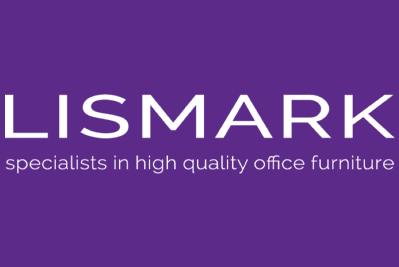
Following guidance from the government, we have implemented measures which allow us to remain open. The health and wellbeing of our staff and clients is our number one priority, so we will continue to review our practices as required according to government advice.
If you have an appointment at your premises with one of our office furniture experts planned, we will aim to keep this appointment with the 2-meter social distancing rule in place. However, if you have an appointment arranged and are self-isolating or displaying symptoms, please let us know.
Again, our delivery service is operating as normal within the social distancing guidance issued by the government.
Our office is open, so if you have any queries or need any help or advice, please do get in touch. We will be pleased to hear from you.
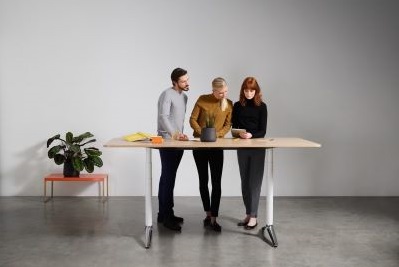
 The last decade has seen the office space evolve from an often bland environment with identikit work stations to a more dynamic environment that reflects a company’s brand identity and caters for new styles of working. The increasing move towards flexible working, hotdesking and open plan workspaces has brought with it incredible furniture innovations.
The last decade has seen the office space evolve from an often bland environment with identikit work stations to a more dynamic environment that reflects a company’s brand identity and caters for new styles of working. The increasing move towards flexible working, hotdesking and open plan workspaces has brought with it incredible furniture innovations.
Some of these modern furniture innovations to watch out for in 2020 include:
The traditional meeting room is no longer a must-have in the modern office but employers should still ensure that there is a space that can meet the same needs of staff. Meeting pods provide a flexible solution for gatherings of up to 8 people and thanks to the privacy they provide, can cater from everything from an informal team catch up over coffee to a confidential client meeting.
The rise of the open plan office has done wonders for team building and collaboration but sometimes privacy is necessary. Whether an employee needs to make an important phone call or settle down to meet a deadline away from the hustle and bustle of the main office, a solo user work pod is an attractive and functional addition to any office.
As we become more aware of the health risks associated with sitting for long periods, many employers are introducing standing meetings as a way to increase the amount of productive time employees spend away from their desks. Not only is there a health benefit, but studies have shown that standing meetings tend to be shorter and those present more focused. A high meeting table is a perfect accompaniment to standing meetings – offering space for participants to use laptops and notebooks without having to strain.
A great alternative to the static high meeting table, a sit-stand meeting table can be adjusted to meet the needs of both sitting and standing meetings. Whilst standing meetings are fantastic for shorter periods, much longer meetings should be at least partially seated. Sit-stand meeting tables
are the perfect option when there is not space for two tables and they work well in either a meeting room or open office environment. When paired with adjustable chairs or stools, individuals can choose whether they would rather sit, perch or stand as they take part in their daily meetings. Choose a table with a smooth electric adjustable function so employees have convenience and flexibility when it comes to reaping the health and productivity benefits of the ability to stand.
Lismark offers a wide range of meeting pods, work pods, high meeting tables and sit-stand meeting tables. If you have any questions or would like a brochure of our modern office furniture products, please get in touch today.

 The negative effects of sitting down for long periods has become common knowledge in offices over recent years. To combat these issues, ergonomic standing desk options have hit the market with force and people are taking a new approach by standing for at least part of their working day.
The negative effects of sitting down for long periods has become common knowledge in offices over recent years. To combat these issues, ergonomic standing desk options have hit the market with force and people are taking a new approach by standing for at least part of their working day.
Standing meetings are not an entirely new concept with agile development teams favouring a daily stand-up meeting to keep things short and on point and some businesspeople choosing to have walking meetings just to fit them into a busy schedule.
As they have become more popular over time new benefits of holding standing meetings have come to light. Studies show that standing meetings are not only shorter than those sat down but are also more constructive. Research suggests that this is driven by increased energy levels and sparked creative thinking when standing – not to mention the benefits for employees’ posture. Traditionally, meetings have always been sat around a standard desk-height meeting table. However, those within the office furniture industry, us included, have seen a huge increase in the popularity of high meeting tables, those used whilst sitting on stools or even standing. It seems that businesses are starting to realise the benefits associated with standing meetings. Sit-stand meeting tables have also risen in popularity as they can be raised for shorter standing meetings or set to a seated height for longer gatherings.
Standing meetings have been shown to be 33% shorter than sitting meetings, and usually take no longer than 15 to 20 minutes.
There is no chance during a standing meeting for staff members to take a quick peek at their mobile, tablet or laptop to check for emails and messages. With fewer opportunities for distractions, staff are more engaged.
A standing meeting can burn up to 50% more calories than a sitting meeting. Compared to sitting in a chair, standing allows for improved blood circulation, oxygen flow, better posture and muscle engagement – all of which can keep you more alert and lead to better creative thinking. Just by using meeting time to stand, this can provide the right healthy balance between standing up and sitting down during a day. It is important to consider how long the meeting may run however as you may want to sit for at least a portion of lengthier meetings.
If you like the idea of a standing meeting with the convenience of a table to take notes and use laptops for presentations it’s well worth considering a sit-stand meeting table or a high meeting table.
With a top height of 1050mm, high meeting tables are perfect for creating a relaxed vibe in your meeting space. The table is flexible in that it can be used by either sitting on high stools or standing. And so, the table becomes multi-purpose – able to be used for standing meetings and for employees to relaxing over coffee.
If you’re becoming tired of unproductive meetings, maybe it is time to make a change – starting with re-thinking your meeting spaces.

 Hot desking is becoming an increasingly popular choice for employers, offering high levels of flexibility enabled by advances in tech that allow us to work from anywhere at any time. However, it’s not a one-size-fits-all solution for every workplace, and before employers take the plunge, some careful planning is a must.
Hot desking is becoming an increasingly popular choice for employers, offering high levels of flexibility enabled by advances in tech that allow us to work from anywhere at any time. However, it’s not a one-size-fits-all solution for every workplace, and before employers take the plunge, some careful planning is a must.
There are significant advantages to hot-desking. One of the largest is that it generally leads to a more efficient use of the space you have, thereby saving on rental and utility costs.
Designed in the right way, hot-desking can also create a friendlier environment where staff benefit from the opportunity to mix with different colleagues every day. It also means that employees aren’t tied to sharing a space with someone who they may not enjoy working with. Ultimately, when it’s done well, hot-desking can result in a more collaborative way of working and a happier team.
The aesthetics of the workplace can also benefit, making it an attractive option for business owners keen to create a modern, pared-back environment to reflect the values of their brand. When people don’t have their own individual spot, they have no option other than to keep their surroundings tidy and streamlined – no more stacks of paperwork and stained coffee cups!
For every pro, there is a con and hot-desking just doesn’t suit every personality or business type. Generally, this new approach to working tends to be favoured by millennials who may be more comfortable with using mobile technology and working flexibly, whether it be from home or a new spot in the office each day.
There is also the risk that hot-desking can depersonalise the workplace, making it feel more transient. Many people feel more comfortable creating their own working space with belongings such as plants, photographs and stationery around them. This can also offer a sense of permanence, with some people arguing that hot-desking could give employees a message that they are not valued enough to have their own desk.
It’s also important to carefully consider any potential challenges around how hot-desking will affect access for employees with reduced mobility or other physical impairments such as poor vision.
That said, many people who are initially resistant to the concept are won over when they try it out and begin to feel its benefits.
Ultimately, the success of hot-desking largely depends on how well the available space is laid out and how the concept it is presented and implemented. It is also usually a prerequisite that at least some staff are partly home or field-based and/or able to work flexible hours to ensure that there is enough space for everyone who is working in the office at any one time.
In a hot-desking environment, it’s also important to provide alternative spaces for meetings and other tasks that need to take place away from the main hub of activity. For example, people will require higher levels of privacy when dealing with confidential or controversial issues, taking important phone calls or collaborating with others.
With the above in mind, here are our recommendations for office furniture options that can make hot-desking work for you.
Choose from single desks, bench-style work stations and moveable desks with built-in cable access. Whichever style, it’s important that they are stationed near power points and can facilitate working on laptops and other mobile devices.
Provide a hot-desking space and an opportunity for employees to tackle the risks of prolonged sitting with a sit-stand desk or sit-stand meeting table.
Individual work pods and meeting pods for groups offer enclosed and private working spaces.
A break-out area with comfortable seating is a must in a hot-desking environment to give employees an alternative space to work and relax in.
As an undeniably attractive and cost-effective option for the modern workplace, it’s well worth giving some thought to whether hot-desking could be just what you need to breathe new life into your workplace whilst reducing your outgoings.
If you’re looking to implement hot-desking in your office, get in touch today to discuss the best furniture options for your space.
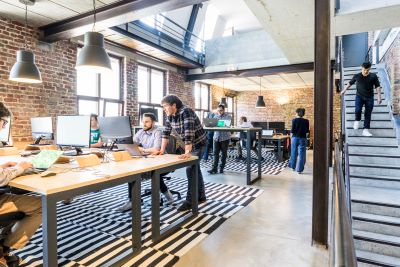
 Open spaces, flexible working and breakout zones are gradually becoming the norm in offices across the country and this is no surprise given how much of the workforce is now comprised of millennials.
Open spaces, flexible working and breakout zones are gradually becoming the norm in offices across the country and this is no surprise given how much of the workforce is now comprised of millennials.
This new wave of personnel is becoming bored with generic working environments and place greater importance on the culture and atmosphere than ever before on where they choose to work. I fact, a recent study found that over a fifth of millennials declined a job offer simply because the business had a poor workplace design and atmosphere.
Business must move with the times to provide an appealing place to work for millennials. Not only so that they don’t decline your job offer, but so that space can be used to its full potential. What puts most off change is the fact that they must invest time and money into such projects, but that doesn’t have to be the case. There are some quick wins for attracting millennials to your workplace:
Conference rooms with long tables and dozens of chairs still have their place but aren’t ideal for millennials who want frequent team gatherings in a more relaxed setting. Not only are breakout zones ideal for holding meetings, but they can also provide a place for taking breaks and making phone calls – making the best possible use of your office space.
Alternative colour schemes and unconventional soft furnishings will make your office space stand out and present the company as creative. Think indoor trees, mind maps, bean bags, artwork, chalkboards, board games; the options are limitless and much of it will depend on your company’s ethos.
Cubicles should now be a thing of the past. Communal spaces which support communication and don’t restrict workers to a desk are preferred by millennials. However, it’s important to offer areas where employees can focus and enjoy some peace amongst the noise of the office. When concentration is needed and deadlines must be met, a quiet area or privacy pod is the ideal retreat.
The line between millennials’ work and home life is far more blurred than for generations before. Many out-of-office friendships are formed at work and an office that fosters an environment to encourage this is great for improving company culture. Facilities or activities that can be easily incorporated into the office such as pool tables, games machines and social zones for breaks are all appreciated by millennials. A greater work from home and flexible working culture also means that only providing static desks with desktop computers may no longer be the best solution. We recommend implementing work booths, larger communal desks or sit-stand desks which are perfect for working at with a laptop.

 Business owners and employees all have a responsibility to consider ways in which they can make their office more environmentally friendly. Although not required by law, it is good practice to have a workable environmental policy in place to help ensure that workplaces are doing what they can to reduce their carbon footprint.
Business owners and employees all have a responsibility to consider ways in which they can make their office more environmentally friendly. Although not required by law, it is good practice to have a workable environmental policy in place to help ensure that workplaces are doing what they can to reduce their carbon footprint.
Measures like going paperless, setting up recycling facilities and reducing waste are all great ways to start, but it’s also important to think about sustainable procurement so you can make ethically responsible choices when making purchasing decisions for the workplace.
There is a growing trend of manufacturers becoming increasingly aware of the important role that they play in creating a more ecologically friendly supply chain. From sourcing sustainable materials to reducing packaging, many companies are taking their environmental responsibilities seriously. So, if you are committed to reducing your carbon footprint, when looking for office furniture, it pays to do your research.
Desks, chairs, sofas – in fact almost anything you find within an office building – can be manufactured from renewable, recyclable or sustainably sourced materials. So, check out what each product is made from before purchase. It’s also worth looking to see and see if the manufacturer or supplier has an environmental policy in place – this can often be found on the website.
Office furniture can be made from a variety of materials, but it’s likely that at least part of a desk, chair or workstation will include some wood. Most ethically sourced products that incorporate wood will have a certification from the Forest Stewardship Council (FSC). This certification guarantees that the wood comes from a sustainable forest and/or has been sustainably harvested so it is an important hallmark to look out for.
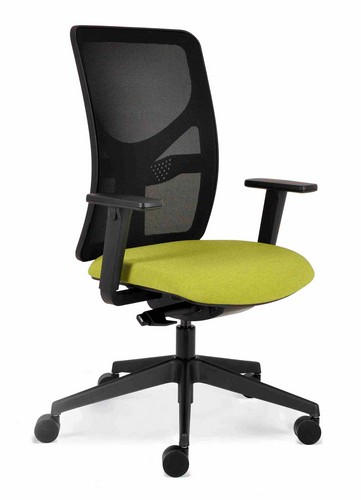
Over recent years we have increasingly moved towards being a throwaway society, but if you are buying cheaper products that frequently need replacing, you need to consider whether this is a false economy. Not only is it damaging to the environment, but it can also end up being a lot more costly over time. It may be a wiser investment both financially and ecologically to purchase higher quality furniture that is likely to have a much longer life.
It’s also important to think about what happens to a piece of office furniture once it comes to the end of its life. Choosing a product with parts that can be recycled makes it a better choice environmentally. For example, both the Solo Ergonomic Task Chair and the Icon Task Chair (pictured) are 95% recyclable at the end of their natural life. Not all manufacturers will include this information in their product description so if you’re not sure just get in touch and we will be happy to help.
Many manufacturers are becoming increasingly resourceful and ecologically minded when sourcing materials. And it’s not just the wood or plastic that can be sustainably produced or recyclable: the way that an office chair or sofa is upholstered can also make a significant difference. For example, one Lismark supplier manufactures environmentally friendly fabrics. In fact, one of their newest fabrics incorporates recycled polyester from used plastic drinks bottles. You can read our blog post on this revolutionary recycled fabric here.
Lighting and heating are likely to account for the largest energy consumption in a standard office, but they can also be managed and reduced easily. Simple measures such as installing LEDs which use 75% less energy and can last more than three times as long as a standard light bulb have an impact. You can even go as far as to install lights controlled by movement sensors to significantly cut energy consumption. These are particularly appropriate in places such as meeting rooms, toilets and kitchens that may not be in constant use.
How you lay out your office can also have an impact on energy consumption. Make the most of natural light by positioning workstations near windows if possible. Keeping workstations away from draughty areas and nearer heat sources can also help keep the office thermostat lower.
Ultimately, creating a more eco-friendly office is about having an overall strategy in place with a range of measures from implementing an ethical purchasing policy to raising staff awareness which, when combined, can make a real difference.
If you want to know more about the eco-friendly office furniture we supply, get in touch today.
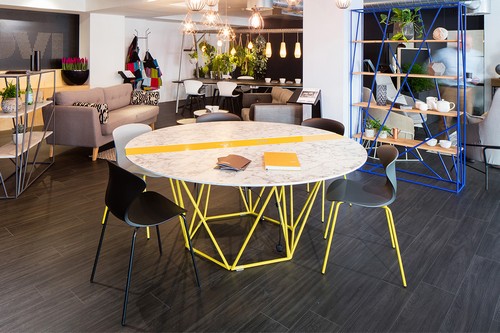
All businesses should strive to be as efficient as possible – regardless of the size of the office. It’s an unfortunate truth that many businesses operate in an office that houses little space, an environment that snaps creativity, productivity and efficiency.
Due to financial restraints, most businesses tend to only upscale business premises once it’s blaringly obvious that they’ve outgrown their current location. And with commercial rents increasing, it’s becoming more difficult for businesses to flock the nest and move into larger premises.
Instead of muddling through in a cramped office space, the better option is to put time into optimising the office space you already own.
So, how do you create an environment that makes employees feel more motivated and productive throughout the working day, whilst making the most of limited office space? As office design and furniture experts, Lismark Office Furniture is on hand to provide you with some useful ways for you to optimise your small office space.
Here is a selection of ways a business can optimise the space in the office:
With a multipurpose space, employees can use the area for catch ups with clients, group meetings and even an alternative working space. Multipurpose spaces allow offices to do more with less space and can add a real tangible boost to productivity.
For open plan offices, a meeting pod can provide relief to workers who need to concentrate in a quiet area and double up as a semi-permanent working space or meeting room.

Office workers spend most of their time indoors so it’s no surprise that an office that is open, has plenty of natural light and is airy performs better. Natural light is a well-known mood booster and also creates a feeling of extra space in a cramped office.
Remove items from windowsills and rearrange desk so that more are positioned close to the windows. If you need some privacy, try sheer blinds or Venetians which can still let light in most of the time.
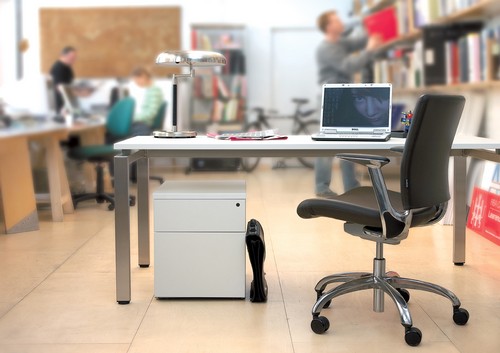
In years gone by, the desk would store an all manner of important files and documents. To cope with the amount of necessary storage, they were heavy duty and contained plenty of compartments for storage.
Because files are now saved on servers and clouds, these desks that eat up plenty of space simply aren’t necessary for the modern day. Where possible, heavy traditional desks should be switched with office desks that are lightweight.
If space is limited, sit-stand desks are invaluable for productive working. Not only do the desks aid health benefits, but they can also be extremely useful for meetings within an office space. Standing together at one computer screen can be far more comfortable than huddling around the screen on chairs. 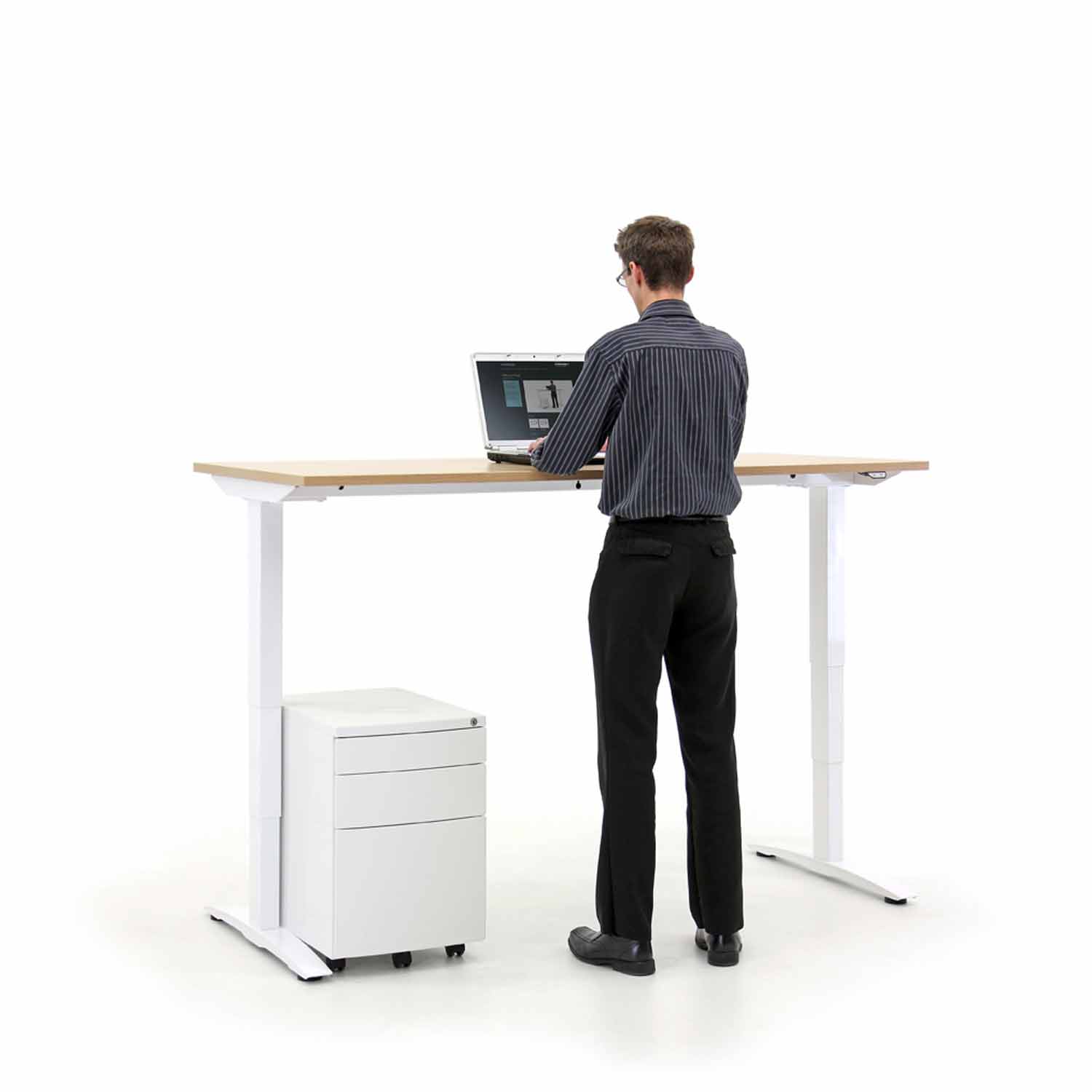
Hot-desking is when personal desks are removed from the office in an effort to save space. It encourages creativity between workers that wouldn’t normally find themselves together and can lead to better team morale and productivity.
Instead of using traditional desks for individual workers, large communal desks that can accommodate more staff. Spaces on these large desks are assigned on a ‘first come, first served’ basis.
Hot desking doesn’t have to solely come in the form of large communal desks, folding tables and laptop tables are space-saving options that can also suit hot-desking workers.
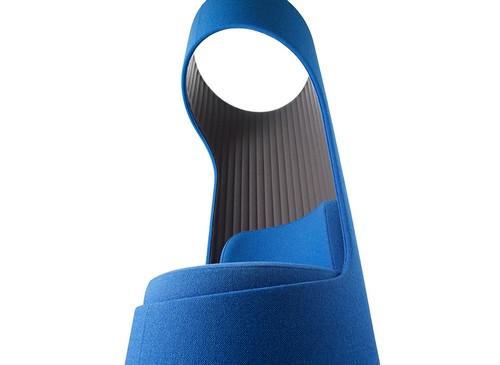
A well-designed office should make use of every possible space – even corridors, staircases and landing areas. These areas that are just used as walkways to connect your office can be reimagined into productivity-boosting areas.
Novelty phone booths for making calls away from the hustle and bustle of the main office could be installed in corridors and beanbags and stools could be arranged in lading areas for impromptu meetings.